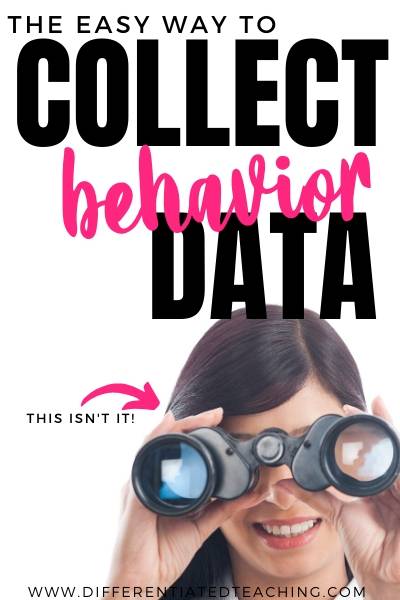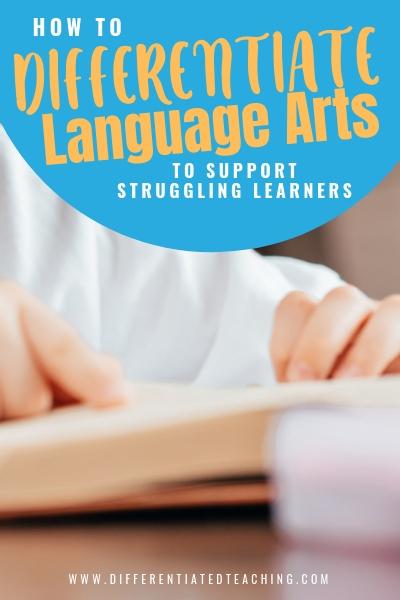The Busy Teacher’s Guide to 504 Plans
Not every student with a disability will come to your classroom with an Individualized Education Plan (or IEP). A 504 Plan is another way districts can create plans to help students with disabilities have success in school.
Whether you’re a new teacher or a seasoned veteran, being handed a 504 Plan can feel overwhelming at first. Understanding what these plans are, how they compare to IEPs, and what’s expected of you can be a massive help in reducing this stress.
Today I want to share more information about 504 Plans and what you can expect at your first 504 meeting.
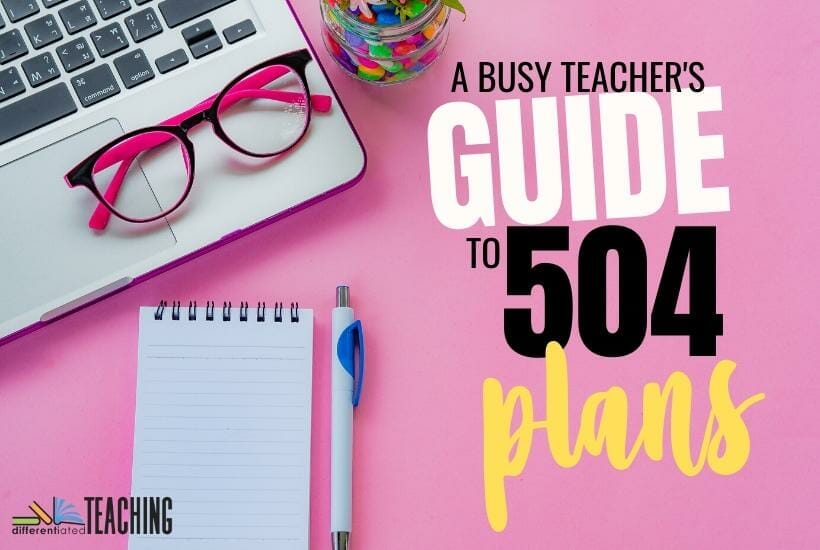
What is a 504 Plan?
A 504 plan is a legal document that outlines how the school will support students with a disability or medical need. It lists the accommodations a student will receive to ensure academic success, including how the environment will be adjusted to help the student learn.
These plans prevent discrimination and help protect the rights of students with disabilities or medical needs in school. They are one piece of the requirements of Section 504 of the Rehabilitation Act, which is an essential piece of civil rights legislation first signed in 1973.
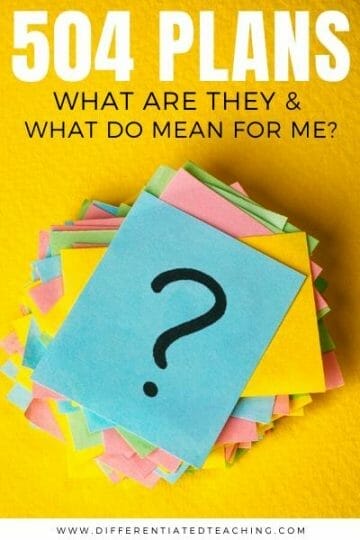
What’s covered under a 504 Plan?
f you haven’t had much experience with these plans, you may be wondering what qualifies for a 504 Plan in your classroom. Legally, children with special needs can receive a 504 Plan if they meet one of the following criteria:
- Have a physical or mental disability that limits one or more life activities.
- Have a record of a disability.
- Being regarded as having a disability.
In other words, the student must have or be perceived as having a disability that limits one or more significant areas of life – like communication, self-care, vision, breathing, learning, or working.

While Section 504 doesn’t list all the qualifying disabilities that would require a plan, it provides examples. This includes things like cerebral palsy, epilepsy, cancer, diabetes, anxiety, depression, learning disabilities, ADHD, allergies, asthma, and more.
The most important consideration is how these impairments limit the student’s ability to perform compared to the typical learner in your classroom.
What are the differences between a 504 Plan and an Individualized Education Plan (IEP)?
After reading about what’s covered under a 504 plan, you might be wondering what the differences between a 504 Plan and an Individualized Education Plan (IEP) are.
Here’s a brief overview:
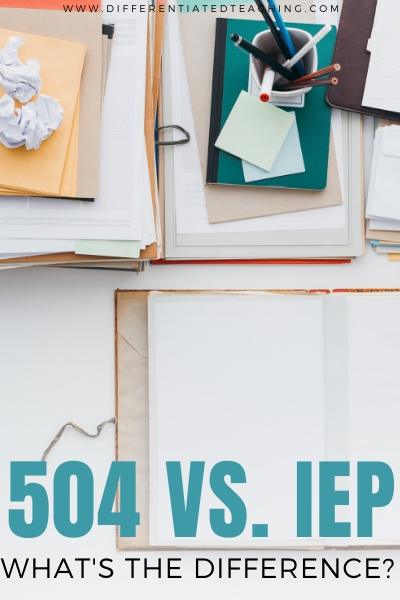
Specialized instruction vs. Accommodations
An IEP, or Individualized Education Plan, is a personalized curriculum specifically designed to address one learner’s strengths and needs.
IEPs are developed based on assessment data indicating the need for specialized instruction. This can include one-on-one support and modifications necessary to help the student progress in identified areas of need.
On the other hand, 504 Plans focus on accommodations only. Students with a 504 Plan are not identified as needing specialized instruction. Instead, they need adjustments to the learning environment that will allow them to access the curriculum.
Goals & the Law
Another difference between an IEP and a 504 Plan is the inclusion of goals. Individualized Education Plans are mandated through the Individuals with Disabilities Act (IDEA) and must include specific goals written to address the student’s needs.
Goals can include academic, behavior, speech, fine motor, gross motor skills, or life skills. The goals guide instruction and are a tool for measuring student progress across the year.
A 504 Plan, which is connected to the Civil Rights – Rehabilitation Act of 1973, focuses on equal access instead of individualized services.
The plans provide accommodations and modifications to allow equal access to the learning environment and curriculum. Students are measured using the same tools and curriculum goals as their peers.
What can I expect to find on the paperwork I receive?
504 Plans contain the personal information you’d expect on any formal school paperwork. However, the most critical part of the 504 paperwork for you, as the teacher, will be the accommodations sections. This section outlines what adjustments you’ll need to make in your classroom.
Here’s what you might find:
- adjustments to the classroom environment – like small group testing
- changes to how the curriculum is shared – like providing the student with notes
- teaching adjustments you’ll need to make – like frequent checks for understanding
The paperwork also indicates which areas the child needs the accommodations to cover and who is responsible for providing them. Understood.org has a great example of a 504 Plan for a child with ADHD that you can take a peek at to see what this looks like in action.
How are these plans created?
A student can qualify for a plan in two ways:
- Parent Request: Parents can bring in disability documentation and request that a 504 Plan.
- School Evaluation: The school can evaluate to determine whether or not a student has unique needs that would warrant a 504 Plan. Parents are before pursuing this route.
What are my responsibilities as the teacher of a student with a plan?
One of the primary responsibilities teachers have is to be an active member of the student’s 504 team. This team, which includes parents and administrators, uses data to determine what adjustments or accommodations are needed to help the student achieve success.
When you attend this meeting, it is essential to bring data on what you’ve been doing to help meet the student’s needs in class and how the student is progressing.
Once the team has created the 504 Plan, it is considered a legal contract between the school and the student. That means you are legally responsible for implementing the accommodations listed in the plan, even if you don’t agree with them.
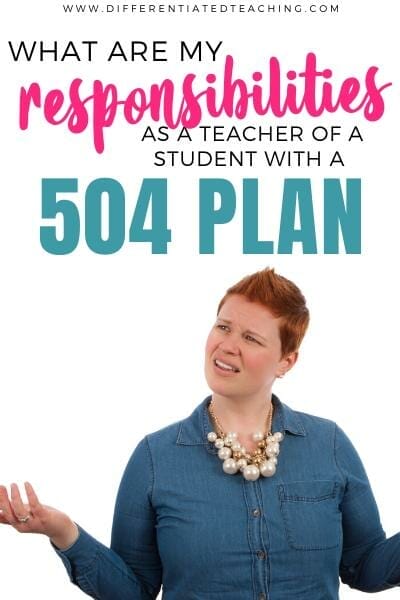
This is why it is so important to attend the 504 meeting and come prepared with data to show what accommodations the student needs.
Keep documentation of how you’re enacting the plan and collect data on how it is working for the student. This can help when the team reconvenes to review the plan and make adjustments each year.
What are some examples of accommodations I might recommend for a student when I’m helping create the 504 Plan?
While the law doesn’t specify what accommodations a student with a disability can receive, there are some common ones that you may see on 504 plans for the students in your classroom. These include (but aren’t limited to):
- Extended time on tests or assignments
- Preferential seating
- Shortened assignments
- Oral administration of testing
- Excused tardies or absences
- Visits to the nurse for medication administration or care
- Visual or verbal aids
- Use of technology aids
What should I expect at a 504 meeting?
A 504 meeting looks similar to an IEP meeting. The student’s team of service providers will come together with the parents to discuss the student’s progress and needs.
You should anticipate the meeting to take anywhere from 20-45 minutes. However, time can vary depending on your school’s system and the child’s situation.
What to bring with you
You’ll want to be sure to come prepared for the meeting. This can help things run more smoothly and reassure parents that you’re supporting their child.
Here’s what you’ll want to make sure you have:
- Data on the student’s current performance – work samples, scores, etc.
- Records of the strategies and accommodations you’re currently using
- Paper and pen for notetaking
- Information on the student’s strengths, talents, and interests
- A list of questions or concerns you have
Your role in the meeting
Your role, as a classroom teacher, is to participate and share data about the student’s progress academically and socially. Come prepared to share the student’s strengths and needs.
Find out more about documenting data in the classroom:
If the student has already had a 504 Plan, and this is an annual review meeting, you’ll also want to come prepared to share how the current accommodations are working in the classroom.
Things to make note of
During the meeting, you’ll want to note any changes that are made to the accommodations and consider what you might need to make these adjustments in your classroom. This will let you initiate these changes more quickly.
Conclusion
While 504 Plans and the process to create them can seem overwhelming at first, once you’ve done them a few times, you’ll find that they are a great way to ensure the adjustments you’re making are documented and the student is making adequate progress.
If you enjoyed this article and want to learn more about supporting students, here are some articles you might enjoy:

